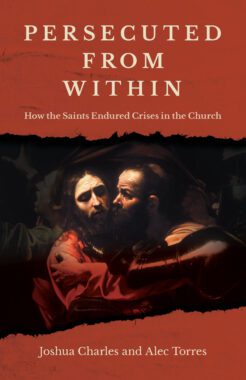“Let what was confessed by the Fathers of Nicaea prevail.” So wrote Athanasius to a philosopher in his final years.
Even to this day, Catholics recite the Nicene-Constantinopolitan Creed at every Mass. We take for granted what St. Athanasius sacrificed so much to defend. It would serve us well to consider why he defended it, and how.
In short, if the Son was not fully God and fully man, then man could not be saved. The essence of Christian salvation, as Athanasius well knew, was humanity’s partaking in the divine nature, as St. Peter had written (2 Pet. 1:4), and as the priest prays at every Mass: “May we share in the divinity of Christ, who humbled Himself to share in our humanity.” But if the divine had not fully assumed human nature, then human nature could no longer partake of the divine. Athanasius explained why this was so vital to the Catholic Faith: “Man had not been deified, unless the Word who became flesh had been by nature from the Father and true and proper to Him. For therefore the union was of this kind, that He might unite what is man by nature to Him who is in the nature of the Godhead, and his salvation and deification might be sure.
And yet, standing up for this most basic and essential truth of the Catholic Faith came at great cost—particularly at the hands of his fellow bishops. All other dogmas depended upon this one. In defending it, St. Athanasius presents Catholics with a model of steadfastness under persecution. He stood by the Council of Nicaea at every turn, never bending to the supposed authoritative statements of other bishops and councils that contradicted its dogmas, even when they presumed to declare him guilty of crimes he did not commit and slandered his reputation. He was anathematized by many, for which he fled to Rome and the papacy for support. While Popes Julius and Liberius ultimately stood by him, there was a point at which even the papacy seemed to founder when Liberius—under duress—subscribed to an Arian creed. Athanasius knew the pope to be orthodox and consistently defended him. But the point is that for a brief time, all the world knew is that the pope had supposedly compromised the Faith. But even then, Athanasius stood firm.
Not only did Athanasius stand firm, the great saint often and explicitly encouraged laymen to do the same. He encouraged them to disobey heretical bishops. He encouraged them to withdraw from parishes taken over by heretical priests. He encouraged them to stand by the Faith of Nicaea as steadfastly as he did.
And yet, Athanasius never saw his actions as opposed to the Catholic Church and her discipline. Quite the opposite. Arianism was a heretical novelty. Thus, anyone presuming to rule, govern, or punish in its name was in fact outside the Church and in opposition to the true Catholic Church. Furthermore, the Church had authoritatively spoken at Nicaea, and so to reject its teaching was heresy—and heretics could have no authority in the Church, and indeed heresy necessarily en-
tailed the loss of office in the Church. As he wrote to the bishops of Egypt and Libya, “Thus Judas was degraded from the Apostolical office, not because he sacrificed to idols, but because he proved a traitor.” And as we saw earlier, he explicitly compared apostolic thrones being physically possessed by heretics to the abomination of desolation prophesied by Daniel. Nicaea had removed all doubt about the Church’s teaching on the second Person of the Trinity, Jesus Christ. To be moved from its determination was to fall from the Faith.
St. Gregory Nazianzen described Athanasius as “the pillar of the Church,” in a time when “the truth of our faith [had] been torn asunder, confused, and parceled out into various opinions and portions by many.” He compared his actions to that of Christ cleansing the Temple:
He cleansed the temple of those who made merchandise of God, and trafficked in the things of Christ, imitating Christ in this also . . . He restored too the teaching which had been overthrown: the Trinity was once more boldly spoken of, and set upon the lampstand, flashing with the brilliant light of the One Godhead into the souls of all.
In our own days, when so many have challenged so many teachings of the Church—even members of the hierarchy—we are faced with a similar challenge as Athanasius, whose spectacular example of steadfastness serves as a model for all Catholics. May we, as St. Gregory Nazianzen recommended, call upon the prayers of this great saint to “cast upon us from above a propitious glance, and conduct this people in its perfect worship of the perfect Trinity, which, as Father, Son,
Holy Ghost, we contemplate and adore.”
+
This article on St. Athanasius: Pillar of the Church is adapted from the book Persecuted from Within by Alec Torres and Joshua Charles which is available from Sophia Institute Press.
Art for this post on a reflection from “Persecuted from Within” by Alec Torres and Joshua Charles: cover used with permission; Photo by Peter Paul Rubens, Public domain, via Wikimedia Commons.






